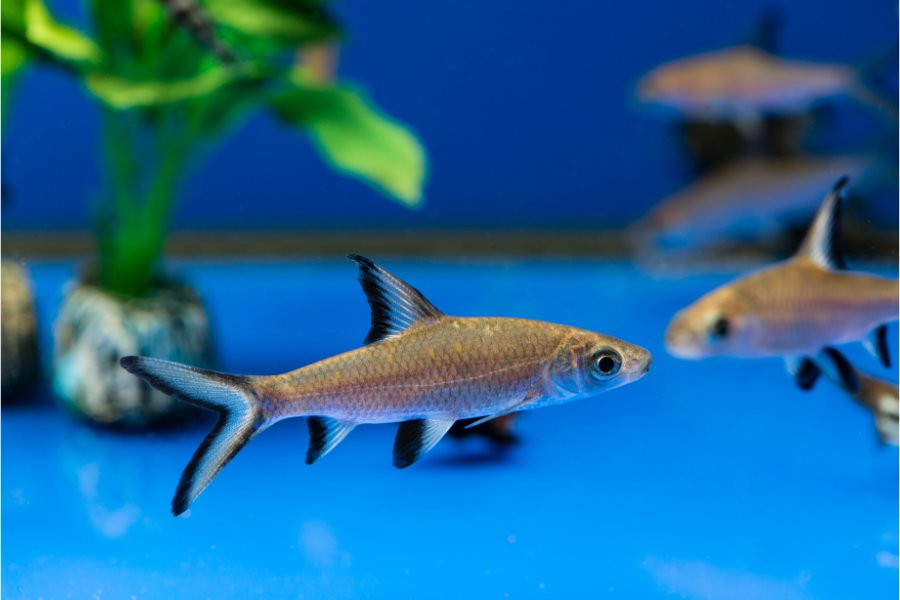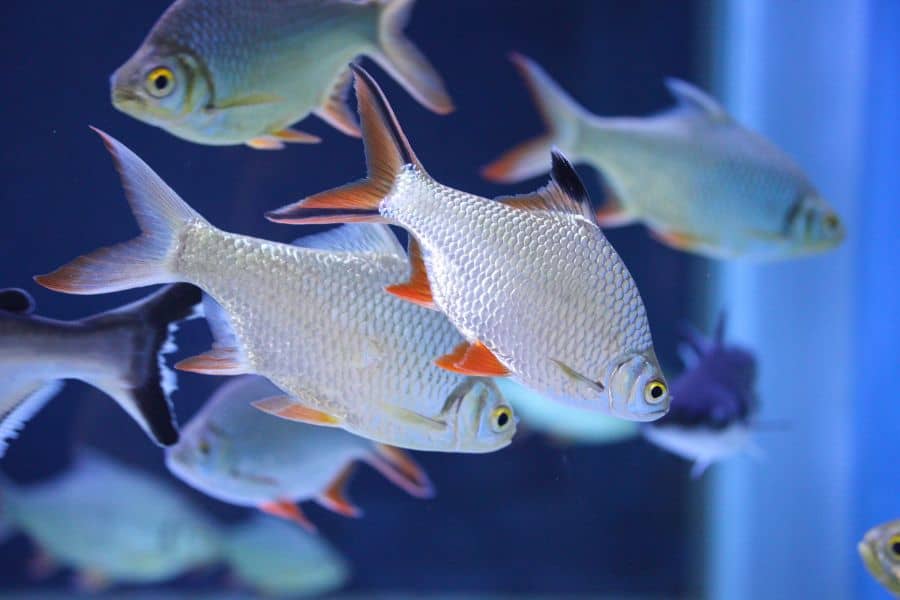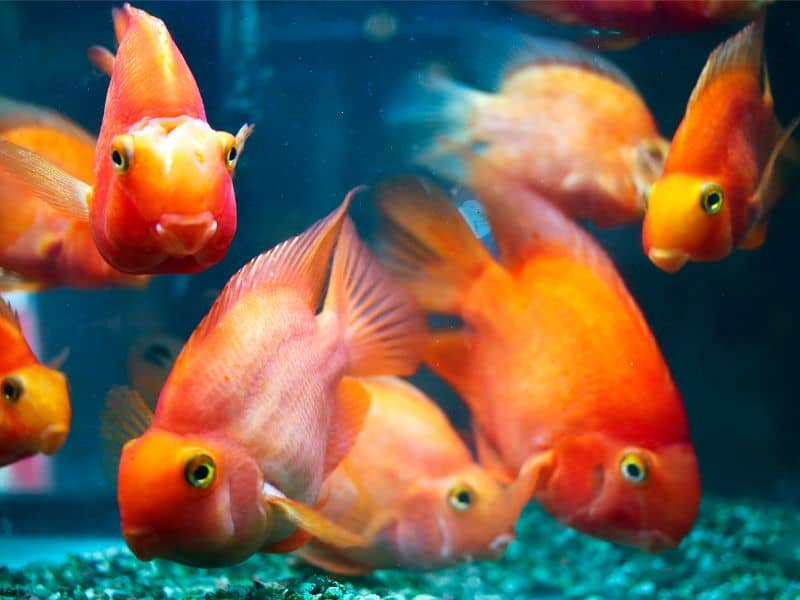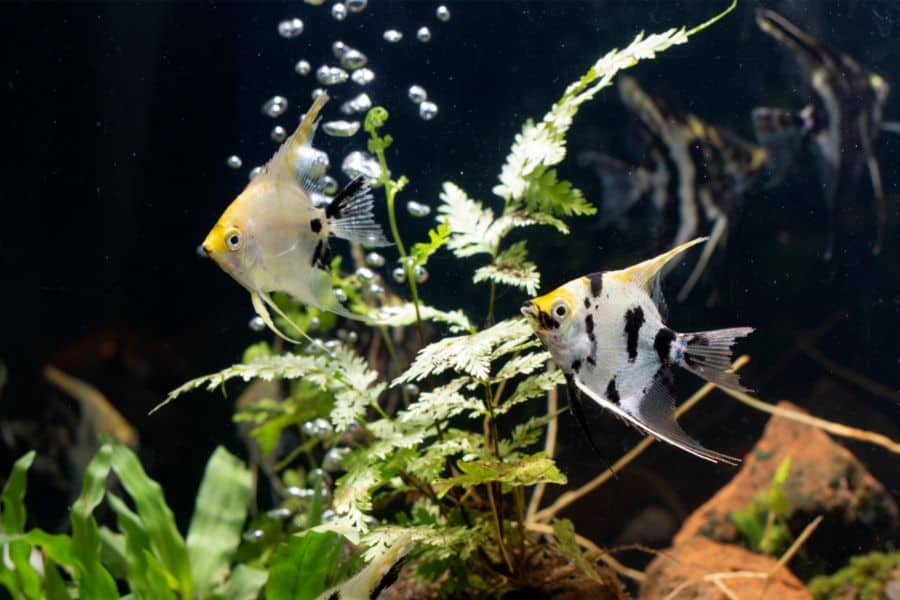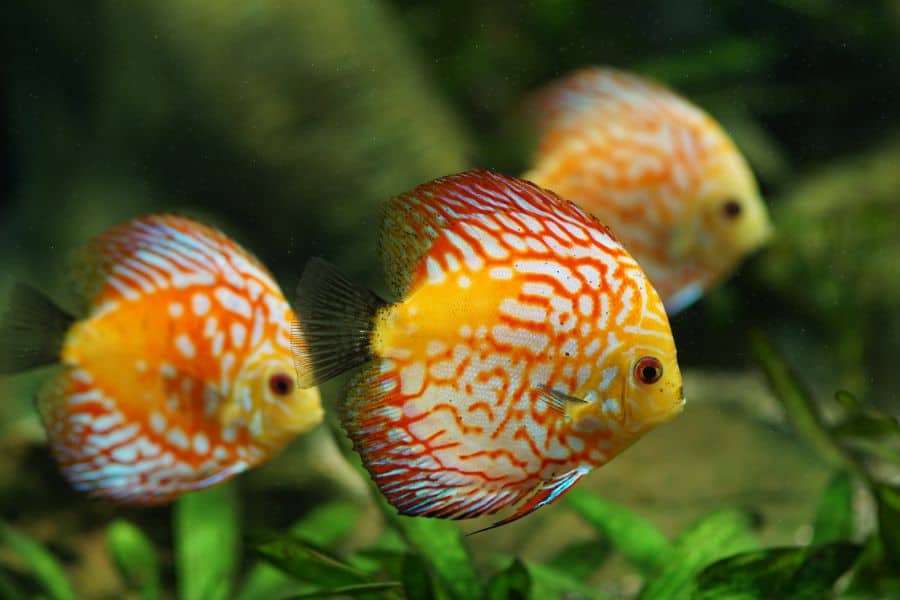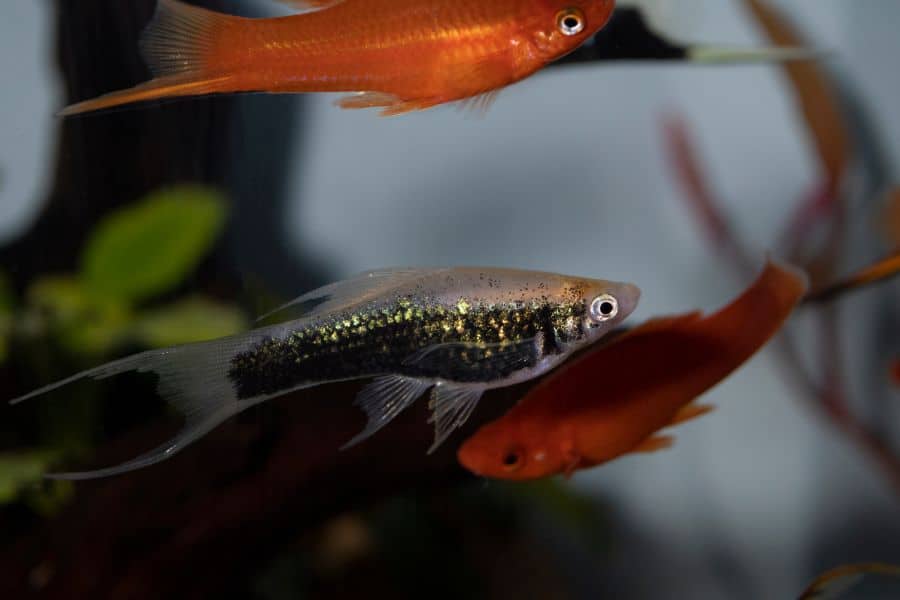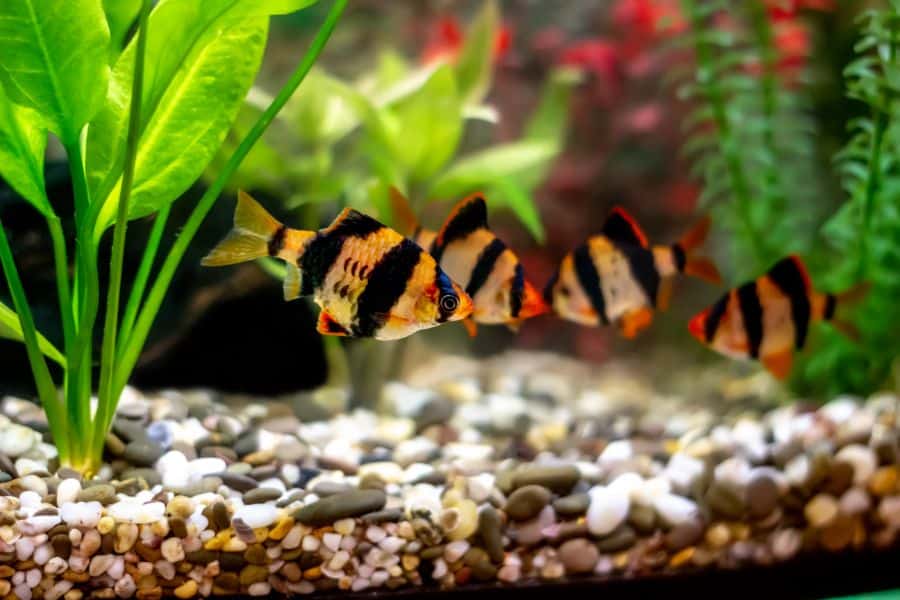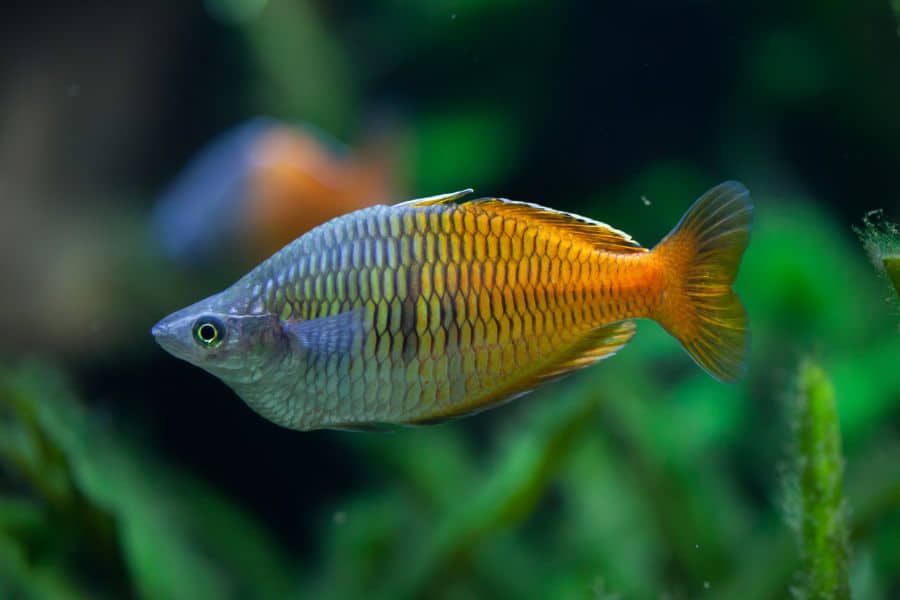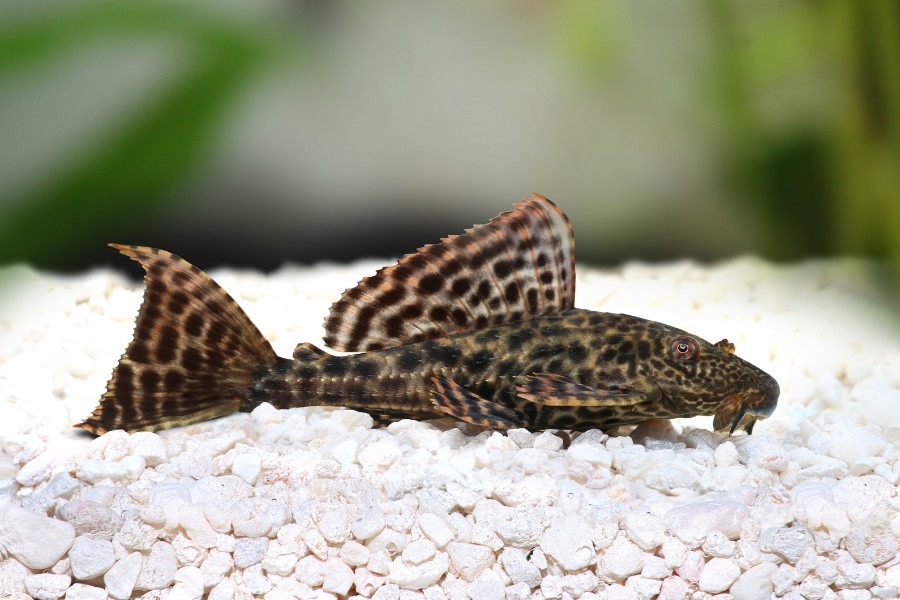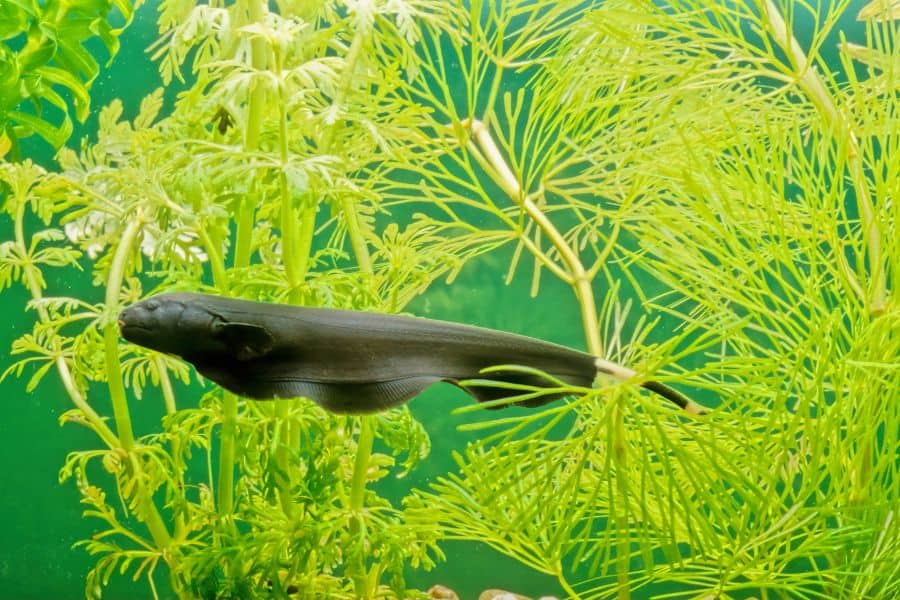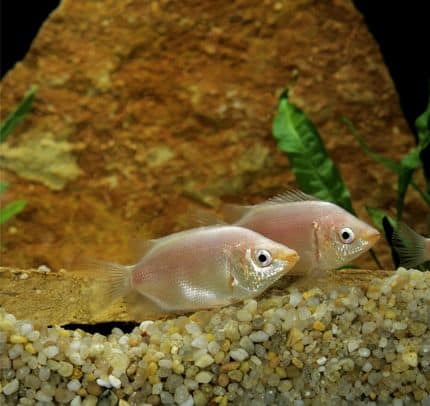When we hear about sharks, the first thing that always comes to our mind is their aggression. It is not always the case, like Bala Sharks (Balantiocheilos melanopterus).
In the first place, Bala Sharks are not real sharks like those we see in Hollywood movies. They are cyprinids and are close cousins of the carp. The reason why they bear a shark name is due to their torpedo-shaped bodies and highly developed fins.
Contrary to the aggressive behavior of real sharks, Bala Sharks are generally peaceful and can coexist with many freshwater aquarium fish.
Do you want evidence? Join us in this article as we present the tank mates for Bala Sharks (as well as what fish to avoid) and the traits that make them compatible.
Ideal Traits for A Bala Shark Tank Mate
Not all freshwater aquarium fish are compatible with Bala Sharks. But if a species has traits similar to those of Bala Sharks, then their coexistence would be harmonious.
Similar in Size
Bala Sharks sold in pet shops are usually juvenile, with sizes ranging from 2 to 4 inches (5 to 10 cm). However, they can grow big, reaching up to 14 inches (35 cm).
Their maximum size also gives you the idea that they don’t thrive in small tanks, and you should keep them in a tank not smaller than 70 gallons (the bigger the better).
There are two situations on how to use and apply their similarity in size.
When you already have an existing Bala Shark in your tank, be sure that when you add a new fish, it should have a similar size to your existing Bala Shark. On the other hand, if you already have other fish in your tank, be sure that the size of the Bala Shark you add has a similar size.
If you disregard stocking similar-sized fish, the consequence is that the smaller fish is often bullied and may be preyed upon by the larger fish.
So, can you imagine stocking a new and tiny fish to an existing and larger Bala Shark or placing a fresh and small Bala Shark to an aquarium that already has larger fish?
Schooling and Active Swimmers
Bala Sharks are fast and active swimmers. Although the exact speed is yet to be determined, they can reach from one end of your tank to the other end in no time. On top of this, they swim in an assembly called a school. It is why they are kept in groups of at least 5 Bala Sharks.
Having these active swimming traits, the perfect tank mate for Bala Sharks should also be an active swimmer and can swim along with their school. It also means that the tank mate you choose should not be territorial.
Otherwise, the swimming space of your Bala Shark becomes limited, and invading one’s space would mean a fight.
Non-Aggressive
With the peaceful behavior of Bala Sharks, make sure that their tank mates should also be unaggressive to maintain a harmonious coexistence. Otherwise, if you place an aggressive fish, it can attack your Bala Sharks, and in predatory species, they may become food.
The non-aggressive behavior is very important since this applies to all sizes of fish. Even a small aggressive fish can still damage your Bala Shark by nipping on their highly protruding fins.
Omnivores
Able to eat both plants and animals, Bala Sharks are omnivores. Having an omnivorous tank mate eliminates the fierce competition for food.
Similar in Water Parameters
All the traits we just mentioned would become useless if the tank mate you choose is incompatible with the Bala Sharks’ water parameters. For you to be aware and for cross-referencing to your chosen tank mate, here are the water parameters for Bala Sharks:
| Parameter | Range |
| Temperature | 22 to 28 C (72 to 82 F) |
| pH | 6 to 8 |
| Hardness | 5 to 12 dGH |
| Ammonia | 0 ppt |
| Nitrite | 0.25 ppm |
| Nitrate | 5 to 10 ppm |
| Lighting | Low to moderate |
The Best Bala Shark Tank Mates: A Quick Glance
| Name | Compatibility Checklist | ||||
| Size | Active Swimmer | Non – aggressive | Omnivore | Water parameters | |
| Tinfoil Barb | ✓ | ✓ | ✓ | ✓ | ✓ |
| Clown Loach | ✓ | ✓ | ✓ | ✓ | ✓ |
| Blood Parrot Cichlid | ✓ | ✓ | ✓ | ✓ | ✓ |
| Angelfish | ✓ | ✓ | x
(✓ if in school) |
✓ | ✓ |
| Discus | ✓ | ✓ | x
(✓ if in school) |
✓ | ✓ |
| Swordtail | x | ✓ | ✓ | ✓ | ✓ |
| Tetra | x | ✓ | ✓
(only to small fish) |
✓ | ✓ |
| Tiger Barb | x | ✓ | x
(✓ only to small fish and if in school) |
✓ | ✓ |
| Boeseman’s Rainbowfish | x | ✓ | ✓ | ✓ | ✓ |
| Pleco | ✓ | x | ✓ | ✓ | ✓ |
| Black Ghost Knife Fish | ✓ | x | ✓ | ✓ | ✓ |
| Kissing Gourami | ✓ | ✓ | x | ✓ | ✓ |
The Best Bala Shark Tank Mates
Tinfoil Barb
Based on the compatibility checklist we made in the previous section, you will see that Tinfoil barbs (Barbonymus schwanenfeldii) are a perfect tank mate for your Bala Sharks.
Both fish are omnivores, grow big, are active swimmers, and originate from Southeast Asia making their required water parameters similar.
Three things to consider in keeping Tinfoil Barbs. First, they need oxygen-rich water. Second, you need to add stones to the substrate to mimic their natural riverbed environment. And lastly, do not keep smaller fish with them as they usually become their food.
Clown loach
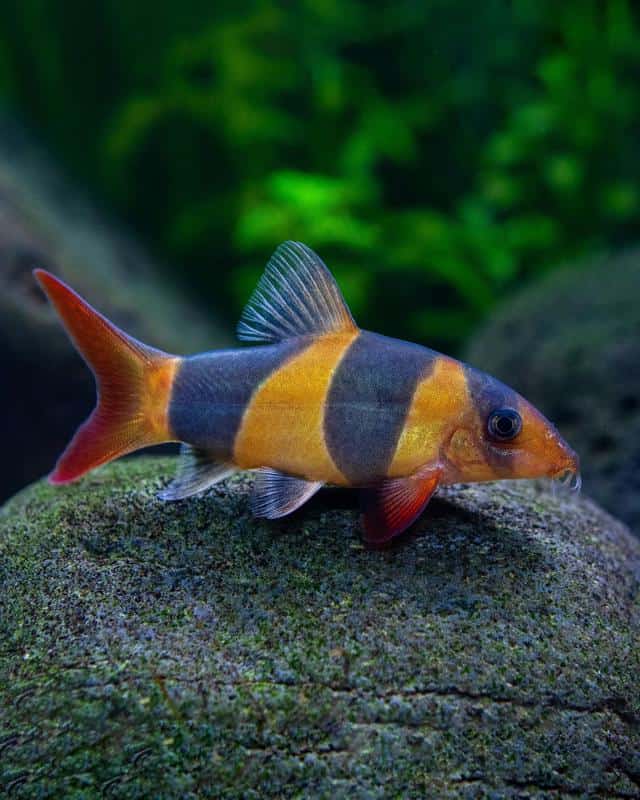
Everything that there is to Clown Loach (Chromobotia macracanthus) is compatible with Bala Sharks.
Clown loaches can grow up to 8 inches (20 cm) which is a couple of inches shy of the adult size of Bala Sharks. They eat anything, from plants to dead matter and unconsumed foods, making them omnivores like Bala Sharks.
What’s great about Clown Loach is how they tightly swim in their school. To have the most aesthetic effect in their swimming school, we recommend you keep at least ten Clown Loaches.
Don’t worry about having more Clown Loaches than Bala Sharks. Their preference to stay near the substrate will not interfere with the midwater nature of Bala Sharks.
Blood Parrot Cichlid
In general, Cichlids are not compatible with Bala Sharks due to their dominant and aggressive behavior. However, there is a hybrid that has become the perfect tank mate for your Bala Sharks – the Blood Parrot Cichlid.
Crossbred from the Redhead and Midas Cichlids, the orange-colored Blood Parrot Cichlids can grow up to 8 inches (20 cm) long and need a lot of space since they are active swimmers.
Although they have sturdy round bodies, the Blood Parrot Cichlid cannot harm your Bala Shark. It’s because their teeth are in their throat, and their mouth is constantly opened.
Angelfish
Angelfish is another type of cichlid compatible with Bala Sharks. Both fish are omnivores, and the water parameters in which they thrive are similar.
Although Angelfish are active swimmers, they are not as fast as Bala Sharks, and they form their own school. The fact is, Angelfish has a hierarchy wherein a fight using their mouth and tail is common for those who want to lead their pack and become their alpha.
With this, you have to watch out for this Angelfish trait. While aggression is confined within their tight social group, Angelfish may become curious to other fish, and their curiosity may lead to fin-nipping.
Fortunately, you can prevent their fin nipping habits if you keep them in groups, ideally from 5 to 8 Angelfish. Remember that boredom is one of the many causes why Angelfish nip other fish’s fins, and having Angelfish in groups keeps them occupied.
Discus
If you have a large brand new tank and plan to place juvenile Bala Sharks, we suggest you also keep juvenile Discus, which in the end, will create a community tank composed of actively swimming fish.
Bala Sharks and Discus are compatible in many ways. Discus originated from the Amazon river, while Bala Sharks are from Southeast Asia, making the water parameters of both fish tropically similar.
In the wild, Discus are carnivores. But being a popular species selectively bred, they have evolved and become omnivores. Aside from consuming a small amount of plant matter (like algae), Discus will also forage in your tank substrate in search of any leftover food.
There are two things to consider in keeping Discus with your Bala Sharks.
First, with their substrate grazing behavior, use fine sand and avoid sharp and pointed objects in the substrate.
Second, keep them in groups of at least 5 Discus of the same size. The reason for this is similar to those of Angelfish. When you only keep one Discus, boredom will easily set in and their attention is drawn to other fish.
Swordtail
If you’re looking for a happy-go-lucky fish where most of its traits are compatible with Bala Sharks, then you will not go wrong with Swordtails (Xiphophorus hellerii).
Being a community fish, Swordtails are compatible with almost all non-aggressive aquarium fish. With their existence with Bala Sharks, although Swordtails are smaller, both fish swim along together and may sometimes go into a swimming race.
Tetras
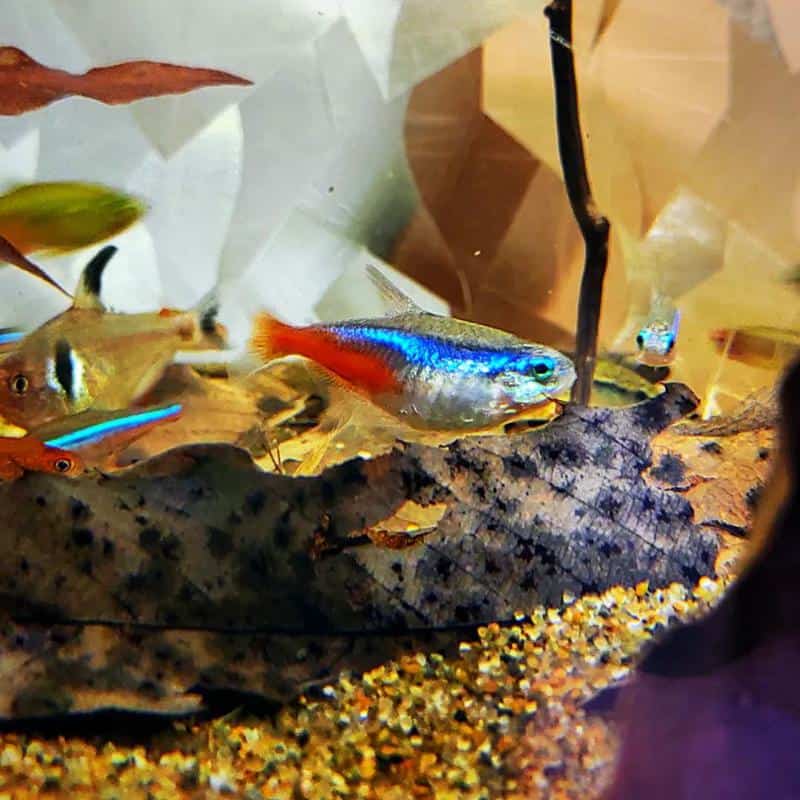
Tetras are popular freshwater aquarium fish readily available in many pet shops. They are known to coexist with many tank mates, including Bala Sharks.
Bala Sharks and Tetras are compatible in many ways. Both fish require a tropical water setting, both are omnivores, and both are active swimmers where Tetras can keep up with the speed of Bala Sharks.
The only downside for Tetras is their small size. But being tiny is not a bad trait since Tetras tend to be aggressive only to fish of similar size.
Also, do not worry about your Bala Sharks getting curious with your Tetras as this tiny fish hides when threatened. With this, adding plants is recommended in keeping tetras with Bala Sharks.
While there are over 150 species of commercially bred tetras, what we recommend for your Bala Sharks are Emperor Tetra, Congo Tetra, Red Eye Tetra, Neon Tetra, Colombian Tetra, and Diamond Tetra.
Tiger Barb
Aquarists love Tiger Barb (Puntius tetrazona) since they are hardy and resistant to most diseases. However, they have a temperament, and males are generally aggressive toward each other.
The key to preventing Tiger Barb aggression lies in their numbers. If they are kept in small groups, their aggressive behavior becomes more pronounced, and they are known to attack other fish.
However, if they are in a group, especially with larger fish like Bala Sharks, Tiger Barb aggression fades and attunes to becoming more of a community fish.
Related: Ideal Tank Mates for Your Tiger Barb
Boeseman’s Rainbowfish
Similar to Tetras, the Boeseman’s Rainbowfish (Melanotaenia boesemani) is one of the few small-sized fish compatible with Bala Sharks. They can only grow up to 4 inches (10 cm) long.
Although small in size, the Boeseman’s Rainbowfish is not intimidated by Bala Sharks since they are often kept in a large group (at least 20). Aside from their similarities in being active swimmers and an omnivore, what sets them apart from Tetras is their peaceful behavior.
Plecos
Every trait of Plecos is perfect for Bala Sharks, except they are not fast swimmers. They usually stick to the glass or stay motionless on the substrate while cleaning your tank by consuming algae.
Plecos being inactive most of the time is, in fact, good for Bala Sharks. It means that Plecos will not interfere with the swimming school of Bala Sharks. However, their laziness will not contribute to the aesthetic beauty brought by the fast swimming traits of Bala Sharks.
Black Ghost Knife Fish
Reaching 20 inches (50 cm) long, the Black Ghost Knife Fish can grow larger than Bala Sharks. Despite being bigger, Black Ghost Knife Fish will not bother your Bala Sharks. The reason for this is their preference to stay at the substrate.
With their unique characteristic of coming in and out of their hiding places, you should provide your Black Ghost Knife Fish with driftwood or rocky mounds.
The combination of Bala Sharks and Black Ghost Knife Fish improves the aesthetic value of your tank. Just imagine this: from top to bottom, there is movement in all parts of your tank.
Please be reminded of two things when keeping Black Ghost Knife Fish. Their flat and elongated bodies don’t have scales, and providing them with fine sand or gravel will prevent body scratches. Also, they are sensitive to sudden changes in water parameters, even if they are similar with those of Bala Sharks.
Kissing Gourami
The Kissing Gourami (Helostoma temminckii) is one of the few aggressive fish compatible with Bala Sharks. They are highly territorial, and they often challenge intruders to a fight.
The supposed kissing between two fish that we all see is not a kiss between a male and a female and has nothing to do with romance or courtship. It is a fight between two males caused by a territorial dispute.
Despite being aggressive, do not worry about keeping Bala Sharks with Kissing Gouramis. Aggression is only triggered when water conditions are not conducive. And the good news is that Bala Sharks and Kissing Gouramis require similar water conditions.
Although they are omnivores, Kissing Gouramis tend to eat more plant material. Knowing this beforehand, only keep live aquarium plants that are hardy and sturdy, like the Java Fern and the Java Moss.
The Worst Bala Shark Tank Mates
Many freshwater aquarium fish cannot meet and satisfy the compatibility checklist for Bala Sharks. It is especially true for small-sized fish, which automatically become food for your Bala Sharks.
In this section, we will only focus on the different species of fish that can potentially harm and endanger your Bala Shark.
Here are the worst tank mates for Bala Sharks based on their compatibility checklist. Take note that they are incompatible mostly on their behavior and water parameters, both of which are crucial for survival and coexistence.
| Name | Compatibility Checklist | ||||
| Size | Active Swimmer | Non – aggressive | Omnivore | Water parameters | |
| Red-tailed Shark | x | ✓ | x | ✓ | ✓ |
| Rainbow Shark | x | ✓ | x | ✓ | ✓ |
| Oscar | ✓ | ✓ | x | ✓ | ✓ |
| African Cichlids | ✓ | ✓ | x | ✓ | ✓ |
| Goldfish | ✓ | ✓ | ✓ | ✓ | x |
Read More:
- Freshwater Aquarium Shark Fish Types
- Roseline Sharks: Care, Diet & Tank Mates
- Chinese High Fin Banded Shark Care
Frequently Asked Questions
Do Bala Sharks Exhibit Aggressive Behavior Toward Their Tank Mates?
Bala Sharks are generally peaceful. However, they can become aggressive under certain circumstances.
For example, the presence of tiny fish triggers Bala Shark aggression as they consider it their food. Being solo or in a small group can also initiate the aggressive behavior of Bala Sharks. So, always keep them in a large school.
Are Bala Sharks Compatible with Other Types of Sharks in A Community Tank?
Yes, but not all. We have already mentioned that Bala Sharks are incompatible with the Red-tailed Shark and the Rainbow Shark due to their aggression.
Some examples of non- aggressive sharks that have traits compatible with Bala Sharks are the Roseline Shark and the Iridescent Shark.
Can You Only Have One Bala Shark in A Tank?
Yes, it is possible. However, it is unethical since it is not their natural set-up. Bala Sharks should thrive in groups.
Keeping them in isolation will not just make them unhappy but also promote aggression where they can attack the moment you add new fish to your tank.
Final Words
Bala Sharks do well in a community tank, and having a compatible tank mate is one of their keys to success.
So, don’t just place any fish with your Bala Sharks, even if you already know that they are not real sharks. You have to remember that Bala Sharks belong to the carp family, and this group of fish is noted for their aggression, especially when it comes to competing for space and food.
On your part, you also have to double your effort since you are now keeping not just your Bala Shark, but also the compatible tank mate you have chosen.
